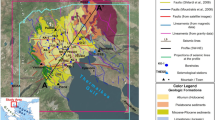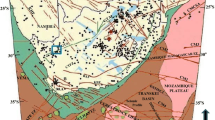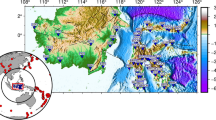Abstract
A ~60 km long Veldurti–Kalva–Gani (VKG) fault is one of the identified strike-slip faults extending from Eastern Dharwar Craton (EDC) to Cuddapah basin in South Indian Shield. The recorded recent seismic activity during year 2012–2016 show occurrences of three microseismic events (< Mw 2.0) in the vicinity of this fault. Historically, no major seismic events are recorded near this fault except magnitude of 5.0–5.9 (1843) earthquake at about ~80 km west of this fault near Bellary. In the present study, analysis of available gravity, aeromagnetic and newly acquired ground gravity and magnetic data in the vicinity of the fault has been carried out to understand subsurface characteristics of this VKG fault and nearby structural features related to recent seismic activity. Analysis of aeromagnetic and gravity data shows shallow origin of the fault and earthquakes are associated with the zone of intersection like cross faults/lineaments which are parallel and perpendicular to the VKG fault. The calculated log normalized radially averaged power spectrum of the available gravity and aeromagnetic data shows four average depths h0 (12.7 km), h1 (6 km), h2 (2.0 km) and h3 (0.5 km). These estimated depths are possibly, bottom of the upper crust, thickness of the Cuddapah basin sediments, horizon of the basic sills, flows and the ferruginous quartzites and cumulative stratigraphic thickness of the Tadpatri shales and the Kurnools in the areas, respectively. The jointly inverted 2-D model from the ground gravity and aeromagnetic data along 2.7 km profile across VKG fault shows, faulting between Banganapalli Quartzite and Tadpatri Shales. The estimated average focal depth from the observed microseismic events is around 13 km. It is concluded from the present study that the observed microseismic events in the vicinity of VKG fault are associated with the intersection zones of cross faults/lineaments near the VKG fault and originated at an average depth of 13 km might be bottom of the upper crust. The estimated depths from the present analysis are well corroborated with previous geophysical studies.
Highlights
-
Mapping of Veldurti–Kalva–Gani fault through gravity, magnetic and aeromagnetic data which is associated with recent seismic activity.
-
Understanding of origin of the seismic activity through spectral analysis.
-
Estimation of depth to the basement, upper crust and thickness of Cuddapah basin sediments in the study region.
-
Estimation of focal depth from seismological data and corroboration with spectral analysis of gravity and aeromagnetic data.













Similar content being viewed by others
References
Anand M, Gibson S A, Subba Rao K V, Kelley S P and Dickin A P 2003 Early Proterozoic melt generation processes beneath the intracratonic Cuddapah Basin, southern India; J. Petrol. 44 2139–2171.
Atchuta Rao D, Sankernarayan P V and Harinarain 1970 A study of the aeromagnetic profiles across the Cuddapah basin; Bull. Nat. Geophys. Res. Inst. 8 129–151.
Babu Rao V, Achutha Rao D, Rama Rao Ch, Sarma B S P, Bhaskara Rao D S, Veera Swamy K and Sarma M R L 1987 Some salient results of interpretation of Aeromagnetic data over Cuddapah basin and adjoining terrain, South India; Geol. Soc. India Memoir 6 295–312.
Balakrishna S and Paul P A 1970 Geological and geophysical studies in parts of Cuddapah basin; Bull. Nat. Geophys. Res. Inst. 8 143–158.
Baranov V 1957 A new method for interpretation of aeromagnetic maps: Pseudo-gravimetric anomalies; Geophysics 22 359–383.
Baranov V and Naudy H 1964 Numerical calculation of the formula of reduction to the magnetic pole; Geophysics 29 67–79.
Bhaskara Rao Y J, Pantulu G V C, Reddy V D and Gopalan K 1995 Time of early sedimentation and volcanism in the Proterozoic Cuddapah basin, South India, evidence from the Pulivendla mafic sill; In: Mafic dyke swarms of Peninsular India (ed.) Devaraju T C, Geol. Soc. India Memoir 33 329–338.
Chandrakala K, Pandey O P, Mall D M and Sarkar D 2010 Seismic signatures of a Proterozoic thermal plume below southwestern part of the Cuddapah Basin, Dharwar craton, India; J. Geol. Soc. India 76 565–572.
Chakraborty K, Mukhopadhyay P K and Pankaj P 2016 Magmatism in western Cuddapahs: The mafic sills and lava flows of Vempalle and Tadpatri formations; J. Geol. Soc. India 87 631–660.
Chandrakala K, Pandey O P, Sesha Sai V V, Vasanthi A and Satish Kumar K 2017 Seismically derived Gondwana and Proterozoic sediments east of Cuddapah Basin, South Indian shield and its possible geotectonic implications, Pure Appl. Geophys. 174 2601–2619.
Chandrakala K, Mall D M, Sarkar D and Pandey O P 2013 Seismic imaging of the Proterozoic Cuddapah basin, South India and regional geodynamics; Precamb. Res. 231 277–289.
Chatterjee N and Bhattacharji S 2001 Petrology, geochemistry and tectonic settings of the mafic dykes and sills associated with the evolution of the Proterozoic Cuddapah Basin of South India; Proc. Indian Acad. Sci. (Earth Planet. Sci.) 110 433–453.
Chetty T R K 2011 Tectonics of proterozoic Cuddapah Basin, southern India: A conceptual model; J. Geol. Soc. India 78 446–456.
Collins A S, Patranabis-Deb S, Alexander E, Bertram C N, Falster G M, Gore R J, Mackintosh J, Dhang P C, Saha D, Payne J L, Jourdan F, Back G, Halverson G P and Wade B P 2015 Detrital mineral age, radiogenic isotopic stratigraphy and tectonic significance of the Cuddapah Basin, India; Gondwana Res. 28 1294–1309.
Coulson L 1933 The Kalva (Calwa) ‘wall’ in the Kurnool district of the Madras Presidency: An example of monoclinal folding, accompanied by faulting, probably along an old line of weakness; Rec. J. Geol. Soc. India 66 438–449.
Crawford A R and Compston W 1973 The age of the Cuddapah and Kurnool systems, southern India; J. Geol. Soc. Australia 19 453–464.
Gay and Jr 1972 Fundamental characteristics of fields anomalies aeromagnetic lineaments their geological significance (The New Basement Tectonics), American Stereo Map Co. Tech. Pub.1, 94.
Geological Survey of India 2000 Seismotectonic Map of India Environs Map No. 33–34.
Geosoft Oasis Montaj 2004 Gravity and magnetic modeling software user guide; Beaverton: Northwest Geophysical Associates, Inc.
Geosoft Oasis Montaj 2006 Data processing and analysis (DPA) system for earth science application, version 6.3 user guide, 2D fast fourier transform and magmap theory, chapter 4, pp. 42–53.
GMSI 2006 Gravity Map Series of India Scale 1:2000,000. NGRI Publication, Hyderabad, India.
GSI 1981 Geological and Mineral map of Cuddapah basin scale: 1:250,000.
Hahn A, Kind F G and Mishra D C 1976 Depth estimation of magnetic sources by means of Fourier amplitude spectra; Geophys. Prospect. 24 287–306.
Havskov and Ottemoller 1999 SeisAn Earthquake analysis software; Seismol. Res. Lett. 70, http://www.seismosoc.org/publications/SRL/SRL_70/srl_70-5_es.html.
Julia J, Jagadeesh, Rai S S and Owens T J 2009 Deep crustal structure of the Indian shield from joint inversion of P wave receiver functions and Rayleigh wave group velocities: Implications for Precambrian crustal velocities; J. Geophys. Res. 114 B10313.
Kaila K L, Roy Chowdhury K, Reddy P R, Krishna V G, Narain Hari, Subbotin S L, Sollogub V B, Chekunov A V, Kharetchko G E, Lazarenko M A and Ilchenko T V 1979 Crustal structure along Kavali–Udipi profile in the Indian peninsular shield from deep seismic sounding; J. Geol. Soc. India 20 307–333.
Kaila K L and Tewari H C 1985 Structural trends in the Cuddapah basin from deep seismic soundings (DSS) and their tectonic implication; Tectonophys. 115 69–86.
Kaila K L, Tewari H C, Roy Chowdhury K, Rao V K, Sridhar A R and Mall D M 1987 Crustal structure of the northern part of the Proterozoic Cuddapah basin of India from deep seismic soundings and gravity data; Tectonophys. 140 1–12.
Kailasam L N 1976 Geophysical studies of the major sedimentary basins of the Indian craton, their deep structural feature and evolution; Tectonophys. 76 225–245.
King W 1872 Kudapah and Karnul Formations in the Madras Presidency; Geol. Surv. India Memoirs 8(1) 346.
Krishna Brahmam N 1989 Gravity and seismicity of the Cuddapah and basin and surrounding places; J. Geol. Sot. Incl. 34 373–384.
Krishna Brahmam N, Sharma J R K, Aravamadhu P S and Subba Rao D V 1986 Explanatory Broucher on Bouguer Gravity Anomaly Map (NGRI/GPH-6) of Cuddapah Basin (India); NGRI, Hyderabad, India.
Krishna V G and Ramesh D S 2000 Propagation of crustal-waveguide-trapped Pg and seismic velocity structure in the south Indian shield; Bull. Seismol. Soc. Am. 90(5) 1281–1294.
Lakshminarayana G and Vijay Kumar 2018 Occurrence of high level magma intrusives and associated mineralization near Gani Inlier, Kurnool Sub-Basin, Cuddapah Basin, India; J. Geol. Soc. India 91 431–440.
Lakshminarayana G, Bhattacharji S and Ramanaidu K V 2001 Sedimentation and stratigraphic framework in the Cuddapah Basin; Geol. Surv. India Spec. Publ. 55 31–58.
Meijerink A M, Rao D P and Rupke J 1984 Stratigraphy and structural development of the Precambrian Cuddapah Basin; Precamb. Res. 26 55–104.
Mall D M, Pandey O P, Chandrakala K and Reddy P R 2008 Imprints of a Protrozoic tectono thermal anomaly below the 1.1 Ga kimberlitic province of southwest Cuddapah basin, Dharwar craton (southern India); Geophys. J. Int. 172 422–438.
Milani E J and Davison I 1988 Basement control and transfer tectonics in the Reconcavo-Tucano Jatoba basin, NE Brazil; Tectonophys. 154 41–70.
Mishra D C, Babu Rao V, Laxman G, Rao M B S V and Venkatarayudu M 1987 Three-dimensional structural model of Cuddapah basin and adjacent eastern part from geophysical studies. In: Purana Basins of Peninsular India (ed.) Radhakrishna B P, Geol. Sot. Ind. Mem. 6 313–330.
Naganjaneyulu K and Harinarayana T 2004 Deep crustal signatures of Eastern Dharwar Craton, India; Gondwana Res. 7 951–960.
Nagaraja Rao B K, Rajurkar G, Ramalingaswamy and Ravindra Babu B 1987 Stratigraphy, structure and evolution of the Cuddapah Basin, Purana Basins of India; Geol. Soc. India Memoir 6 33–86.
Naidu P S 1970 Statistical structure of aeromagnetic field; Geophysics 35 279–292.
Narayanaswami S 1959 Cross folding en echelon folding in Precambrian rocks of India and their relationto metalogenesis; Geol. Soc. India Memoir 1 80–104.
Narayanaswami S 1966 Tectonics of Cuddapah Basin; J. Geol. Soc. India 7 33–50.
NGRI 1985 Report on aeromagnetic survey over northern and southern part of Cuddapah basin and adjoining crystallines; Unpublished technical report no. 85, 238.
NGRI 2001 Report on search for provinces of block rotation using aeromagnetic data interpretation on some selected geological terrains; Unpublished technical report no. NGRI-2001-EXP-320.
Pandey O P, Chandrakala K, Vasanthi A and Satish Kumar K 2018 Seismically imaged shallow and deep crustal structure and potential field anomalies across Eastern Dharwar Craton, south Indian Shield: Possible geodynamical implications; J. Asian Earth Sci. 157 302–316.
Patranabis-Deb S, Saha D and Tripathy V 2012 Basin stratigraphy, sea-level fluctuations and their global tectonic connections – evidence from the Proterozoic Cuddapah Basin; Geol. J. 47 263–283.
Prabhakara Prasad P, Satish Kumar K, Seshunarayana T and Rama Rao Ch 2013 New approach for interpretation of scattered ground magnetic data in a part of Delhi Fold Belt–NW Indian shield; Arabian J. Geosci. 7 2633–2639.
Prasanti Lakshmi M and Ram Babu H V 2002 Basement structure of the southwestern part of the Cuddapah Basin from aeromagnetic anomalies; Curr. Sci. 9 1378–1381.
Qureshy M N, Krishna Brahmam N, Arawamadhu P S and Naqvi S M 1968 Role of granitic intrusions in reducing the density of the crust and other related problems as illustrated from a gravity study of the Cuddapah basin, India; Proc. Roy. Soc. London Ser. A 304 449–464.
Rai S S, Priestly, Keith, Suryaprakasam K, Srinagesh D, Gaur V K and Du Z 2003 Crustal shear velocity structure of the south Indian shield; J. Geophys. Res. 108 1093–1098.
Rajaram Narender C B, Neelima Satyam D and Pradeep R Kumar 2010 Preliminary seismic hazard map of peninsular India, 14th SEE-2010 479-491.
Ram Babu H V 1993 Basement structure of the Cuddapah Basin from gravity anomalies; Tectonophys. 223 411–422.
Rama Rao C, Kishore R K, Pradeep Kumar V and Butchi Babu B 2011 Delineation of intra crustal horizon in eastern Dharwar Craton – an aeromagnetic evidence; J. Asian Earth Sci. 40 534–541.
Rama Rao Ch, Chetty T R K, Lingaiah A and Babu Rao V 1991 Delineation of a greenstone belt using aeromagnetics, Landsat and photogeology – A case study from the south Indian shield; Geoexploration 28 121–138.
Rama Rao J V, Murty N V S and Balakrishna B 2013 Imprints of Gadwal–Raichur Schist Belt Beneath Cuddapah Sediments, Evidences from Gravity and Magnetic Anomalies, Kurnool Area, Andhra Pradesh; J. Geophys., Vol. XXXIV, 2: 95 to 99, AEG Publication, Hyderabad.
Rama Rao J V, Murty N V S and Balakrishna B 2008 Report on ‘regional gravity and magnetic (TF) surveys in Topo sheet No. 56 H/12, 16 (Full) & 57 I/1,2,5 & 6 Under Project: Geophysical Mapping’ Field Season: 2007–08, GSI (unpublished report).
Reddy P R, Chandrakala K and Sridhar A R 2000 Crustal velocity structure of the Dharwar Carton, India; J. Geol. Soc. India 55 381–386.
Saha D and Tripathy V 2012a Palaeoproterozic sedimentation in the Cuddapah Basin, South India and regional tectonics: A review; In: Palaeoproterozic of India (eds) Mazumder R and Saha D, Geol. Soc. London, Spec. Publ. 365 161–184.
Saha D and Tripathy V 2012b Tuff beds in Kurnool sub-basin, southern India and implications for felsic volcanism in Proterozoic intracratonic basins; Geosci. Frontiers 3 429–444.
Satish Kumar K, Kishore R K, Parveen Begum, Seshu D and Rama Rao Ch 2015 Estimation of depth extent of Gangam–Peruru complex of Eastern Dharwar Craton (EDC) from aeromagnetic data; Arabian J. Geosci. 8 2681–2686.
Sen S N and Narasimha Rao Ch 1967 Igneous activity in Cuddapah basin and adjacent areas and suggestions on the palaeogeography of the Basin; Proceedings of symposium on Upper Mantle Project. NGRI, Hyderabad, pp. 261–284.
Sesha Sai V V 2014 Pyroclastic volcanism in Papaghni sub-basin, Andhra Pradesh: Significant Paleoproterozoic tectonomagmatic event in SW part of the Cuddapah basin, Dharwar Craton; J. Geol. Soc. India 83 355–362.
Singh A P and Mishra D C 2002 Tectonosedimentary evolution of Cuddapah Basin and Eastern Ghats Mobile Belt (India) as Proterozoic collision: Gravity, seismic and geodynamic constraints; J. Geodyn. 33 249–267.
Singh A P, Mishra D C, Gupta S B and Prabhakar Rao M R K 2004 Crustal structure and domain tectonics of the Dharwar craton (India): Insight from new gravity data; J. Asian Earth Sci. 23 141–152.
Sitharam T G, Anbazhagan P and Ganesha Raj K 2006 Use of remote sensing and seismotectonic parameters for seismic hazard analysis of Bangalore; Nat. Hazards Earth Syst. Sci. 6 927–939.
Spector and Bhattacharyya 1966 Energry density spectrum and auto correlation function of anomalies due to simple magnetic models; Geophys. Prospects 14 242–272.
Spector A and Grant F S 1970 Statistical models for interpreting aeromagnetic data; Geophysics 35 293–302.
Srinagesh D, Chadha R K, Solomon Raju P, Suresh G, Vijayaraghavan R, Sarma A N S, Sekhar M and Murty Y V V B S N 2015 Seismicity studies in eastern Dharwar Craton and neighbouring tectonic regions; J. Geol. Soc. India 85 419–430.
Sheppard S, Birger Rasmussen, Jian-Wei Zi, Somasekhar V, Srinivasa Sarma D, RamMohan M, Bryan Krapež, Simon A Wilde and Neal J McNaughtond 2017 Sedimentation and magmatism in the Paleoproterozoic Cuddapah Basin, India: Consequences of lithospheric extension; Gondwana Res. 48 153–163.
Talwani M and Heirtzler J R 1964 Computation of magnetic anomalies caused by two-dimensional bodies of arbitrary shape; In: Computers in the mineral industries. Part 1: Stanford University Publication (ed.) Parks G A, Geol. Sci. 9 464–480.
Talwani M, Worzel J L and Landisman M 1959 Rapid gravity computations for two-dimensional bodies with application to the Mendocino submarine fracture zone; J. Geophys. Res. 64 49–59.
Tripathy V and Saha D 2013 Plate margin, palaeostress variations and intercontinental deformations in the evolution of the Cuddapah basin through Proterozoic; Precamb. Res. 235 107–130.
Won I J and Bevis M 1987 Computing the gravitational and magnetic anomalies due to a polygon: Algorithms and Fortran subroutines; Geophysics 52 232–238.
Acknowledgements
The authors record their sincere thanks to Dr V M Tiwari, Director of NGRI, for granting permission to publish this paper. Authors are sincerely thankful to Dr Ch Rama Rao for his constant encouragement and guidance. In the course of writing this paper, various persons of the Seismology Division of NGRI unreservedly rendered their help, which is gratefully acknowledged. The authors sincerely thank the Editor and anonymous reviewers for fruitful suggestions that helped to improve the MS. NGRI Library reference no: NGRI/Lib/2019/pub-124.
Author information
Authors and Affiliations
Contributions
KSK: Manuscript writing, field planning, data collection, processing and interpretation, PSS: Ground gravity and magnetic data collection and processing, SPB: Aeromagnetic data analysis, BL: Ground gravity and magnetic data collection, PMD: Topographic data collection, VMLN: Ground gravity data collection, PSR: Seismological data analysis and DS: Manuscript writing and overall supervision.
Corresponding author
Additional information
Communicated by N V Chalapathi Rao
Rights and permissions
About this article
Cite this article
Satish Kumar, K., SivaSankar, P., Parveen Begum, S. et al. Appraisal of Veldurti–Kalva–Gani (VKG) fault, Cuddapah Basin, India: Gravity and magnetic approach. J Earth Syst Sci 130, 40 (2021). https://doi.org/10.1007/s12040-020-01519-5
Received:
Revised:
Accepted:
Published:
DOI: https://doi.org/10.1007/s12040-020-01519-5




